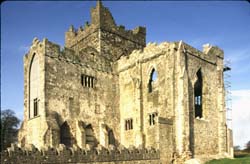 |
 |
 |
 |
 |
 |
 |
|
|
Cistercian Abbeys: TINTERN PARVA Name:
TINTERN Location: Bannow Bay County:
Wexford Tintern, or Little Tintern, was founded by William Marshal, earl of Pembrokeshire and Lord of Leinster. Tradition says that during a journey to Ireland William encountered a violent storm and vowed to found an abbey wherever he could safely land. William finally reached safety at Bannow Bay and he subsequently bequeathed about 9000 acres of land to the monks of Tintern Abbey in Wales, of which he was patron. A colony of monks arrived from Tintern in the autumn of 1200. The abbey is sometimes referred to as Tintern de Voto, which means ‘Tintern of the vow’. Following its foundation, Tintern acquired vast tracts of land in County Wexford, and it soon became one of the wealthiest of the Cistercian houses in Ireland. The monks of Tintern, who were Anglo-Norman in origin, supported the Cistercian General Chapter during the ‘conspiracy of Mellifont’.(1) In 1228 Stephen of Lexington held an assembly of Cistercian abbots at Tintern, after he had conducted two visitations of the Irish abbeys.(2) In 1277 the abbot of Tintern was deposed for his failure to attend the General Chapter for many years.(3) Towards the end of the thirteenth century the original stone church was abandoned and replaced with a new one. In 1477 it was reported that the lands were much wasted and the abbot rebuilt the abbey at great cost to himself.(4) At the time of the Dissolution the annual income of the abbey was valued at £96, which made it the third richest Cistercian house in Ireland, after St. Mary’s Dublin and Mellifont.(5) The abbey was suppressed in 1536, but the monks remained at the abbey for some years following. In 1541 the royal commissioners reported that the abbey church had been used for parochial purposes for some time prior to the Dissolution, and that all other buildings were necessary for the farmer.(6) In the 1550s the property passed to Anthony Colclough, an officer in Henry VIII’s army. Colclough converted the crossing tower into a fortified residence and subsequently he, or one of his immediate successors, converted the chancel into another dwelling house. In the eighteenth century, Sir Vesey Colclough constructed a series of embattled walls around the abbey and in the 1790s John Colclough converted the nave into a residence in the neo-gothic style. The last member of the family to reside in the abbey was Lucey Marie Biddulph ColClough who left in 1959. Four years later the property was taken into state care. Conservation work was begun in the 1980s and extensive excavations took place in 1982-3. They revealed much of the foundation work and exposed many of the features of the original abbey. The remains include the nave, chancel, tower, chapel and cloister. The chancel at Tintern is nothing more than a shell and the tracery of the windows has long been torn away. There is a well-preserved exterior corbel table and the south transept has a rib-vaulted eastern aisle originally divided into three separate chapels.(7) The ruins are situated on the west shore of Bannow Bay. The site is now managed by Heritage of Ireland and can be accessed by the public at all reasonable times.
|
